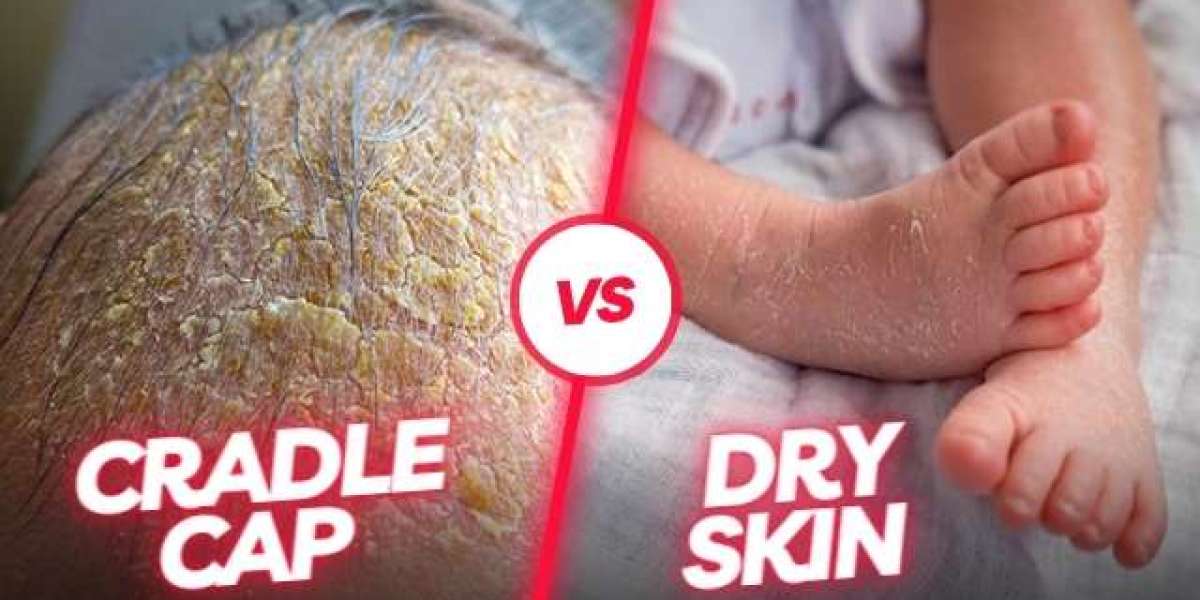New parenthood comes with a whirlwind of emotions and, often, a sprinkle of worry. One common concern parents face is the appearance of flaky patches or crusty bumps on their baby's scalp. Is it cradle cap vs. dry scalp? Are they dealing with a harmless annoyance or something more serious? Fear not; this article will clear up the confusion and equip you with the knowledge to navigate these skin conditions confidently.
What's the Difference?
While both cradle cap and dry scalp involve flaking skin on the scalp, there are key distinctions:
- Oiliness: Cradle cap is characterized by oily, thick, yellowish or red patches. On the other hand, a dry scalp is just that – dry, with white or light-coloured flakes. Imagine a cradle cap like greasy dandruff, while a dry scalp resembles regular dandruff.
- Texture: Cradle cap patches feel rough and bumpy, whereas dry scalp typically manifests as finer, flaky skin.
- Location: Cradle cap usually appears on the scalp but can also spread to eyebrows, behind ears, and the diaper area. The dry scalp is primarily limited to the scalp.
Case Study: a new mom, Sarah, noticed white flakes on her baby Liam's scalp. They weren't oily and didn't seem to bother him. This is likely a dry scalp, a common and easily manageable condition.
Remember: Cradle cap vs dry scalp boils to oiliness, texture, and location.
Unveiling the Causes: Cradle Cap vs. Dry Scalp
Cradle Cap: The exact cause remains a mystery, but it's likely a combination of factors:
- Yeast Overgrowth: Malassezia, a yeast naturally present on the scalp, can overgrow due to a newborn's immature oil glands. This triggers an inflammatory response, leading to a cradle cap.
- Newborn Hormones: After birth, newborns inherit maternal hormones. These hormones can stimulate oil production, contributing to cradle cap development.
Dry Scalp: Several factors can cause dry scalp in babies:
- Dry Weather: Cold, dry winter air can zap moisture from your baby's delicate skin, leading to a dry scalp.
- Sensitive Skin: Some babies are naturally prone to dry skin, making them more susceptible to a dry scalp.
- Skin Conditions: Eczema, a chronic inflammatory skin condition, can manifest on the scalp as dry, itchy patches.
Remember: Cradle cap vs. dry scalp—yeast overgrowth and hormones versus dry weather, sensitive skin, or eczema.
Soothing the Scalp: Treatment Options
The good news? Both cradle cap and dry scalp are usually harmless and treatable. Here's how to help your little one:
Cradle Cap:
- Gentle Cleansing: Wash your baby's hair regularly with a mild, fragrance-free baby shampoo. This helps loosen the greasy scales.
- Scalp Massage: After shampooing, gently massage your baby's scalp with a soft brush or washcloth to remove flakes. Be very gentle to avoid irritating the skin.
- Moisturizing: If the scales are stubborn, apply a small amount of petroleum jelly or baby oil to soften them before brushing.
Dry Scalp:
- Hydration is Key: Ensure your baby is well-hydrated by offering breastmilk or formula regularly. A well-hydrated body translates to healthier skin.
- Humidifier Power: Use a cool-mist humidifier in your baby's room, especially during dry winter. This adds moisture to the air, preventing further dryness.
- Gentle Cleansing: Avoid harsh shampoos and opt for gentle, fragrance-free ones similar to cradle caps. Wash your baby's hair less frequently if necessary.
Remember: Cradle cap vs. dry scalp – similar treatment approaches focus on gentle cleansing and adding moisture.
When to See a Doctor:
While most cases of cradle cap and dry scalp resolve on their own, consult your paediatrician if:
- The condition worsens or doesn't improve after a few weeks of home care.
- The patches become red, inflamed, or infected.
- Your baby seems uncomfortable or itchy.
- You suspect your baby might have eczema.
Conclusion:
Cradle cap and dry scalp, while in different conditions, can cause initial worry for new parents. But remember, armed with their distinguishing features and simple treatment strategies, you can effectively soothe your baby's scalp and brighten those little smiles.
So, the next time you see flakes on your baby's head, take a deep breath, assess the oiliness, texture, and location, and follow the tips above. With a little TLC, your baby's scalp will be happy and healthy in no time!
Cradle cap and dry scalp are two examples of minor skin conditions that can arise during infancy. Familiarizing yourself with common baby skin concerns can equip you to handle them calmly and confidently. Consider creating a baby skincare reference guide with your paediatrician to keep handy and refer to whenever a new skin issue pops up.






